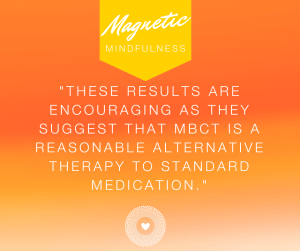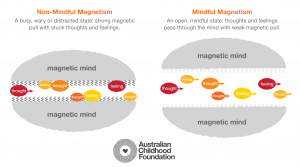
Magnetic Mindfulness
An exploration of mindfulness as a strategy for work with young people.
This blog article was co-authored by Matt Harvey, Therapeutic Specialist at ACT Together and Lauren Thomas, Manager at the Australian Childhood Foundation.
In the last decade, mindfulness has become one of the biggest buzzwords. From yogi’s to neuroscientists, parents and professionals, everyone has a method, an app or a process they’re using to ‘practice’ this skill. But what is mindfulness and why does it matter?
Although a quick google search will serve you up a plethora of descriptions, there are some agreed-upon principles essential to all which are found in Jon Kabat Zin’s definition:
“the awareness that arises from paying attention, on purpose, in the present moment and non-judgmentally”. – Jon Kabat Zin
Mindfulness involves intentional awareness and attention being placed on the present moment, without judgement. Many activities such as breathing, eating, dancing and exercising can be performed mindfully, but intentionality is key to the practice.
Why does being mindful matter? What is all the fuss about? In a review of more than 20 randomized controlled trials in 2011, it was shown that mindfulness can help improve overall mental health. Research into what happens when people practise these skills has shown impacts on a wide variety of areas including
– ability to regulate emotions,
– decrease stress, anxiety and depression
– helping us to focus our attention,
– improving our ability to observe our thoughts and feelings without judgment.
In one trial, Mindfulness-based cognitive therapy (MBCT) was compared with anti-depressant medication use. For participants who experienced unstable remission, it found that 73% of had a reduction in the risk of relapse in both the MBCT and the antidepressant group compared with a placebo. These results are encouraging as they suggest that MBCT is a reasonable alternative therapy to standard medication. Mindfulness may also offer additional benefits, not just in being able to help alleviate distress, but it can also lead one into a state of mind where they are flourishing (Brensliver, 2016).
 It seems clear that, over time, with daily practice, Mindfulness can enable us to become more present in our lives and with others, can help us to make better decisions, to manage our emotions and to be more fully engaged in life. So it is no wonder that governments are funding research and the development of apps to enable our populations to learn more with ease.
It seems clear that, over time, with daily practice, Mindfulness can enable us to become more present in our lives and with others, can help us to make better decisions, to manage our emotions and to be more fully engaged in life. So it is no wonder that governments are funding research and the development of apps to enable our populations to learn more with ease.
In his regular work with children, young people and families, one of our Therapeutic Specialists, Matt Harvey, was exploring how we might explain the benefits of mindfulness or strike up a conversation about it with young people.
He describes what might be a typical conversation:
Adult: Ummm… you see, Bobby, mindfulness is the gym for your mind.
Bobby: What if I don’t want to go to the gym?
Adult: Umm well, you should try it. It helps you relax and ease your mind…
Bobby: Last time I tried it all I did was think about stuff I didn’t want to.
These conversations aren’t always straight forward! In conversation with Matt, he describes an analogy he likes to use:
Every day we have thousands of thoughts passing through our mind.

Unfortunately, sometimes we think thoughts we don’t want to think. Those thoughts get stuck and magnetize in our minds. If emotions such as fear, anxiety, sadness, guilt, or worry can attach to the thought, the thought gets even bigger and has more magnetic attraction in our mind.
So what mindfulness attempts to do is reduce the power of the magnets so that those thoughts can pass through our minds easier. The more we practice mindfulness, the weaker the magnets in our mind get, allowing thoughts to pass easier.
The three parts that Matt describes as being involved in reducing the mind’s magnetism are:
- Acceptance: Just realizing thoughts are going to always come through our mind but we can choose to accept them for what they are. Just thoughts and nothing else and therefore not allow them to magnetize or get stuck.\
- Breathing: Our mind can only focus on one thing at a time. So by focusing only on our breath we aren’t focusing on those tricky magnetic thoughts. This takes practice, but each time we stop thinking a thought and return to the breath we are learning this skill, so if this is all you do when you practice mindfulness you are actually getting it!
- Commitment: Just like going to the gym it might take a week or more before we notice any real change. We also might not like it to start with because it exposes us to some thoughts, to begin with, rather than being distracted from them. However, the more we practice we eventually see progress as the magnets indeed get weaker and make it easier to let thoughts pass through our mind.
To help expand this analogy and enable therapists to explore it further with children and young people, we developed a pdf resource which is available for download. If you have further ideas, analogies or resources to use in exploring mindfulness with children and young people, we’d love to hear from you! Please feel free to comment in the space provided below.
References
Beddoe, A & Murphy, S. 2004. Does Mindfulness Decrease Stress and Foster Empathy Among Nursing Student? Journal of Nursing Education, 43(7), 305-312.
Brensilver, M. (2016, August 03). Mindfulness and Psychiatric Medication. Retrieved June 17, 2020, from https://www.mindfulschools.org/research-and-neuroscience/mindfulness-psychiatric-medication/
Chiesa, A., & Serretti, A. (2010). A systematic review of neurobiological and clinical features of mindfulness meditations. Psychological Medicine, 40(08), 1239–1252.
Goldin, P. R., & Gross, J. J. (2010). Effects of mindfulness-¬based stress reduction (MBSR) on emotion regulation in social anxiety disorder. Emotion, 10(1), 83.
